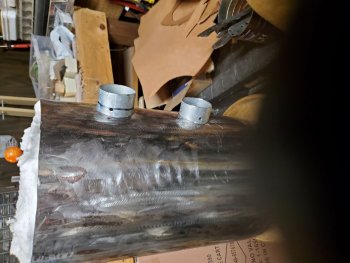Sean Jones
Well-Known Member
I'm back to working on a forge build very similar to the one that Gliden07 is building. Here's a photo of where I am at.

Now I'm at the point where I need to either find someone who can weld my project or as an alternative use JB Weld Exteme Heat for the bungs and also likely for the legs. Though I'm hoping I can use bolts.
So would the JB Weld extreme heat work? I don't know anyone personally who has a welder I can use, so I'd have to pay someone. I have no idea how much they would charge. But the JB Weld would certainly be less expensive if it's doable.
Also, are these tubes for the burners long enough?
And finally how far from the forge itself should the propane tank sit? I purchased one of Harbor Freights little red carts, the two shelf kind. My propane tank is taller than the top shelf so my plan is to cut an opening in the top shelf of the cart for the propane tank. The tank itself would sit on the bottom shelf. This would mean the valve would be within about 12" of the forge. Is that too close? I don't want a propane tank exploding from ambient heat!

Now I'm at the point where I need to either find someone who can weld my project or as an alternative use JB Weld Exteme Heat for the bungs and also likely for the legs. Though I'm hoping I can use bolts.
So would the JB Weld extreme heat work? I don't know anyone personally who has a welder I can use, so I'd have to pay someone. I have no idea how much they would charge. But the JB Weld would certainly be less expensive if it's doable.
Also, are these tubes for the burners long enough?
And finally how far from the forge itself should the propane tank sit? I purchased one of Harbor Freights little red carts, the two shelf kind. My propane tank is taller than the top shelf so my plan is to cut an opening in the top shelf of the cart for the propane tank. The tank itself would sit on the bottom shelf. This would mean the valve would be within about 12" of the forge. Is that too close? I don't want a propane tank exploding from ambient heat!
Last edited:





